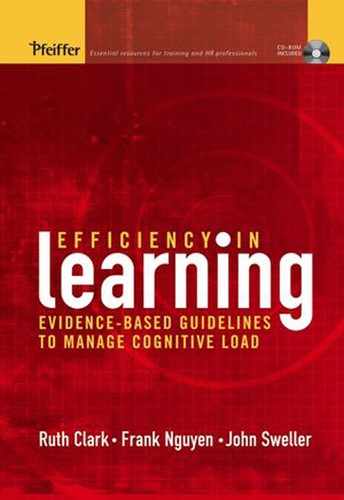Getting the Most from This Resource
In this era of information overload and greater work complexity, instructional professionals are increasingly asked to accelerate the speed and quality of the learning process. This book provides you with evidence-based guidelines on how to create efficient instructional environments which result in faster learning, better learning, or both. At the core of Efficiency in Learning are instructional guidelines that work in harmony with human learning processes.
This book was written for all instructional professionals in organizational training settings who are seeking proven methods to create efficient learning environments. This includes classroom and synchronous e-learning instructors, as well as designers and developers of classroom and multimedia instructional materials.
In addition to the book, we include a CD with the following elements:
Asynchronous e-learning demonstration lesson that violates our guidelines: Before Overloaded Excel Web-Based Lesson
Commentary on this lesson by Dr. John Sweller
Asynchronous e-learning demonstration lesson that applies our guidelines: After Load Managed Excel Web-Based Lesson
Commentary on this lesson by Dr. John Sweller
Synchronous e-learning demonstration lesson that applies our guidelines: Virtual Classroom Example
Commentary on this lesson by Dr. John Sweller
A video discussion by Dr. John Sweller on the research and guidelines in this book organized by chapter
Working Aid: Applying Cognitive Load Theory to your Training
The CD is used to illustrate instructional strategies that cannot be captured in a book, such as audio narration, color, animation, and adaptive testing. We provide specific references to various elements of the CD throughout the text and at the end of each chapter point you to related contents on the CD. We also recommend that instructors using this book as a class text make use of these resources as an integral part of their instructional plan. For example, a class introductory exercise could assign students to review the Before Overloaded asynchronous demonstration lesson that violates our guidelines and make a list/discuss what they think is wrong with the example.
The book is organized into five parts as follows:
Part I. An Introduction to Efficiency in Learning (Chapters 1 and 2)
This part provides an introduction to efficient learning that introduces cognitive load theory and overviews the scientific definition and metric for efficiency, as well as the human learning processes from which cognitive load theory is derived.
Part II. Basic Guidelines for Managing Irrelevant Cognitive Load (Chapters 3 through 8)
This part provides guidelines and supporting research for the use of graphics, text, and audio proven to make learning more efficient. It also discusses ways to reduce memory load by (1) eliminating extraneous content or themes, (2) imposing mental work gradually through appropriate lesson organization, and (3) replacing some practice exercises with worked examples.
This part focuses on proven ways to help learners build new knowledge and skills through the use of diverse examples, better learner processing of examples, and rehearsal of new content.
Part IV. Tailoring Instruction to Learner Expertise Chapters 10 and 11)
This part offers guidelines and examples of ways to tailor your training for novice and experienced learners. It summarizes a model for adaptation of instruction in asynchronous e-learning environments based on a new technique of rapid testing.
Part V. Cognitive Load Theory in Perspective (Chapters 12 and 13)
This part provides a retrospective look at the previous chapters. In Chapter 12 we integrate all of our previous guidelines into a context familiar to instructional professionals, and in Chapter 13 John Sweller discusses the past, present, and future of cognitive load theory from a personal perspective.
The appendix provides mathematical details regarding calculation of the efficiency metric as well as a review of basic statistical concepts, including statistical significance and effect size.
The glossary provides definitions of the cognitive load terminology used throughout the book.
Each chapter in the book includes:
Several guidelines for instructional professionals along with examples, the research, and psychology supporting those guidelines
Summaries and application checklists to aid instructional professionals to apply the guidelines
A guide to the resources on the CD relevant to that chapter
Recommended readings for individuals desiring more information on the chapter theme
The guidelines and examples in this book are based on over twenty-five years of valid experimental research conducted by John Sweller and his associates throughout the world. Many training professionals will recall the recommendation to shape their instruction around the "magical number of 7 plus or minus 2" in order to avoid overloading their learners. Cognitive load theory is the 21st Century update to that maxim. Cognitive load theory is a comprehensive and proven instructional theory that illustrates ways to reduce unproductive forms of cognitive load and at the same time maximize productive sources of cognitive load that lead to efficient learning environments. Chapters 1 and 2 provide an overview of cognitive load theory, which is the foundation for this book.
